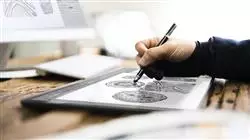University certificate
The world's largest faculty of video games”
Introduction to the Program
Take advantage of this opportunity and specialize in Illustration and Multimedia Design, opening the doors of the best companies in the video game industry"

Multimedia design and illustration are key elements in the creation of video games, as they contribute greatly to their visual appeal and gameplay experience. So, today, video games are a constantly evolving and growing industry, and multimedia and illustration designers have a key role to play in creating innovative and exciting products that attract audiences and keep them hooked. Keeping up to date with the latest techniques and software is crucial in this area to ensure that designs are effective and live up to the public's expectations.
The Advanced master’s degree in Illustration and Multimedia Design is an advanced program designed specifically for those interested in specializing in video game design. The program's syllabus covers a wide range of topics, from graphic design and 2D and 3D animation, to 3D modeling and design for television and film products. Students will have the opportunity to acquire advanced skills and knowledge to create innovative multimedia designs that will make their video games stand out. In addition, the program includes modules on character creation, world creation and the application of visual effects, among others.
One of the main advantages of the Advanced master’s degree in Illustration and Multimedia Design is that it is 100% online, which means that students can study at their own pace, with no time or location restrictions. In addition, students will have access to online learning resources such as technical videos, case studies and theoretical and practical exercises, among many others.
Illustration plays a fundamental role in the development of today's video games: master the main tools in this area thanks to the Advanced master’s degree of TECH"
This Advanced master’s degree in Illustration and Multimedia Design contains the most complete and up-to-date program on the market. The most important features include:
- The development of case studies presented by experts in professional illustration and multimedia design
- The graphic, schematic, and practical contents with which they are created, provide scientific and practical information on the disciplines that are essential for professional practice
- Practical exercises where the self-assessment process can be carried out to improve learning
- Its special emphasis on innovative methodologies in the creation of multimedia pieces and illustrations and multimedia illustrations
- Theoretical lessons, questions to the expert, debate forums on controversial topics, and individual reflection assignments
- Content that is accessible from any fixed or portable device with an Internet connection
Develop all your talent with TECH and participate in the best audiovisual projects as an illustrator and multimedia designer"
Its teaching staff includes professionals from the field of design, who bring to this program the experience of their work, as well as recognized specialists from leading companies and prestigious universities.
Its multimedia content, developed with the latest educational technology, will provide the professional with situated and contextual learning, i.e., a simulated environment that will provide an immersive learning experience, programmed to prepare in real situations.
This program is designed around Problem-Based Learning, whereby students must try to solve the different professional practice situations that arise throughout the program. For this purpose, the professional will be assisted by an innovative interactive video system created by renowned and experienced experts.
Master the latest techniques and software in video game design thanks to this Advanced master’s degree"

Study at your own pace, without time restrictions, thanks to TECH's 100% online methodology"
Why study at TECH?
TECH is the world’s largest online university. With an impressive catalog of more than 14,000 university programs available in 11 languages, it is positioned as a leader in employability, with a 99% job placement rate. In addition, it relies on an enormous faculty of more than 6,000 professors of the highest international renown.

Study at the world's largest online university and guarantee your professional success. The future starts at TECH”
The world’s best online university according to FORBES
The prestigious Forbes magazine, specialized in business and finance, has highlighted TECH as “the world's best online university” This is what they have recently stated in an article in their digital edition in which they echo the success story of this institution, “thanks to the academic offer it provides, the selection of its teaching staff, and an innovative learning method aimed at educating the professionals of the future”
A revolutionary study method, a cutting-edge faculty and a practical focus: the key to TECH's success.
The most complete study plans on the university scene
TECH offers the most complete study plans on the university scene, with syllabuses that cover fundamental concepts and, at the same time, the main scientific advances in their specific scientific areas. In addition, these programs are continuously being updated to guarantee students the academic vanguard and the most in-demand professional skills. In this way, the university's qualifications provide its graduates with a significant advantage to propel their careers to success.
TECH offers the most comprehensive and intensive study plans on the current university scene.
A world-class teaching staff
TECH's teaching staff is made up of more than 6,000 professors with the highest international recognition. Professors, researchers and top executives of multinational companies, including Isaiah Covington, performance coach of the Boston Celtics; Magda Romanska, principal investigator at Harvard MetaLAB; Ignacio Wistumba, chairman of the department of translational molecular pathology at MD Anderson Cancer Center; and D.W. Pine, creative director of TIME magazine, among others.
Internationally renowned experts, specialized in different branches of Health, Technology, Communication and Business, form part of the TECH faculty.
A unique learning method
TECH is the first university to use Relearning in all its programs. It is the best online learning methodology, accredited with international teaching quality certifications, provided by prestigious educational agencies. In addition, this disruptive educational model is complemented with the “Case Method”, thereby setting up a unique online teaching strategy. Innovative teaching resources are also implemented, including detailed videos, infographics and interactive summaries.
TECH combines Relearning and the Case Method in all its university programs to guarantee excellent theoretical and practical learning, studying whenever and wherever you want.
The world's largest online university
TECH is the world’s largest online university. We are the largest educational institution, with the best and widest online educational catalog, one hundred percent online and covering the vast majority of areas of knowledge. We offer a large selection of our own degrees and accredited online undergraduate and postgraduate degrees. In total, more than 14,000 university degrees, in eleven different languages, make us the largest educational largest in the world.
TECH has the world's most extensive catalog of academic and official programs, available in more than 11 languages.
Google Premier Partner
The American technology giant has awarded TECH the Google Google Premier Partner badge. This award, which is only available to 3% of the world's companies, highlights the efficient, flexible and tailored experience that this university provides to students. The recognition as a Google Premier Partner not only accredits the maximum rigor, performance and investment in TECH's digital infrastructures, but also places this university as one of the world's leading technology companies.
Google has positioned TECH in the top 3% of the world's most important technology companies by awarding it its Google Premier Partner badge.
The official online university of the NBA
TECH is the official online university of the NBA. Thanks to our agreement with the biggest league in basketball, we offer our students exclusive university programs, as well as a wide variety of educational resources focused on the business of the league and other areas of the sports industry. Each program is made up of a uniquely designed syllabus and features exceptional guest hosts: professionals with a distinguished sports background who will offer their expertise on the most relevant topics.
TECH has been selected by the NBA, the world's top basketball league, as its official online university.
The top-rated university by its students
Students have positioned TECH as the world's top-rated university on the main review websites, with a highest rating of 4.9 out of 5, obtained from more than 1,000 reviews. These results consolidate TECH as the benchmark university institution at an international level, reflecting the excellence and positive impact of its educational model.” reflecting the excellence and positive impact of its educational model.”
TECH is the world’s top-rated university by its students.
Leaders in employability
TECH has managed to become the leading university in employability. 99% of its students obtain jobs in the academic field they have studied, within one year of completing any of the university's programs. A similar number achieve immediate career enhancement. All this thanks to a study methodology that bases its effectiveness on the acquisition of practical skills, which are absolutely necessary for professional development.
99% of TECH graduates find a job within a year of completing their studies.
Advanced Master's Degree in Illustration and Multimedia Design
Illustration and multimedia design are two creative disciplines that have become highly relevant in today's digital era. The demand for trained professionals in these areas has increased considerably due to the growing need for engaging and effective visual content in digital media, advertising, marketing, video games and many other industries. At TECH Global University, a global leader in distance learning, we have developed an Advanced Master's Degree in Illustration and Multimedia Design that will provide you with the skills and knowledge you need to excel in this exciting area.
At TECH Global University, a global leader in distance learning, we have developed an Advanced Master's Degree program in Illustration and Multimedia Design that will provide you with the skills and knowledge you need to excel in this exciting area.
This virtual postgraduate program is designed for students to gain an in-depth understanding of the fundamentals of illustration and multimedia design, including drawing techniques, color, composition, character design, visual storytelling and relevant software tools. Students will also have the opportunity to explore different stylistic approaches and apply them to practical projects. In addition, advanced topics such as animation, user interface design, user experience design and interactive multimedia content development will be addressed. Our hands-on, project-oriented approach will allow you to develop a strong portfolio that will help you stand out in the competitive field of illustration and multimedia design.







